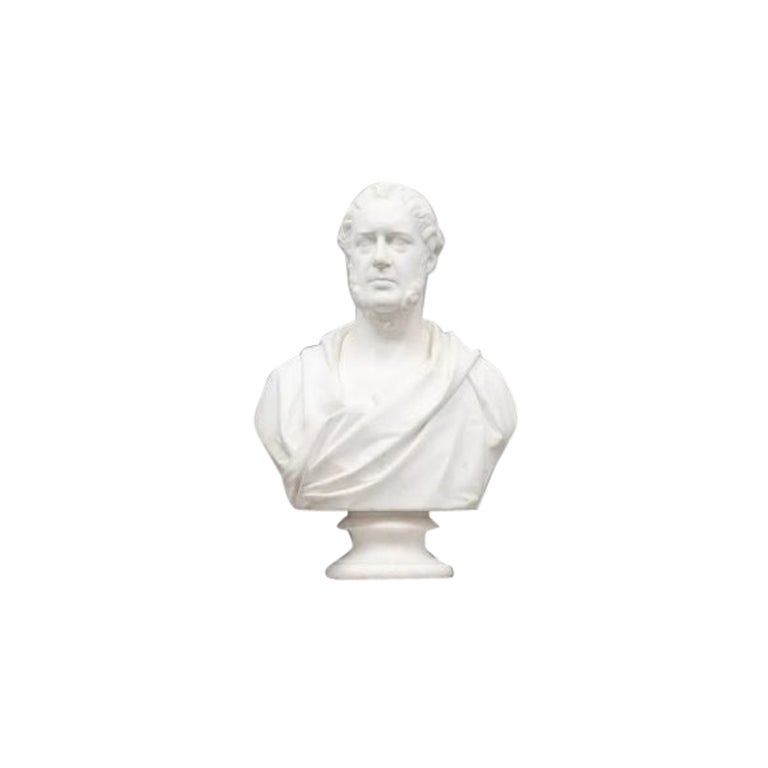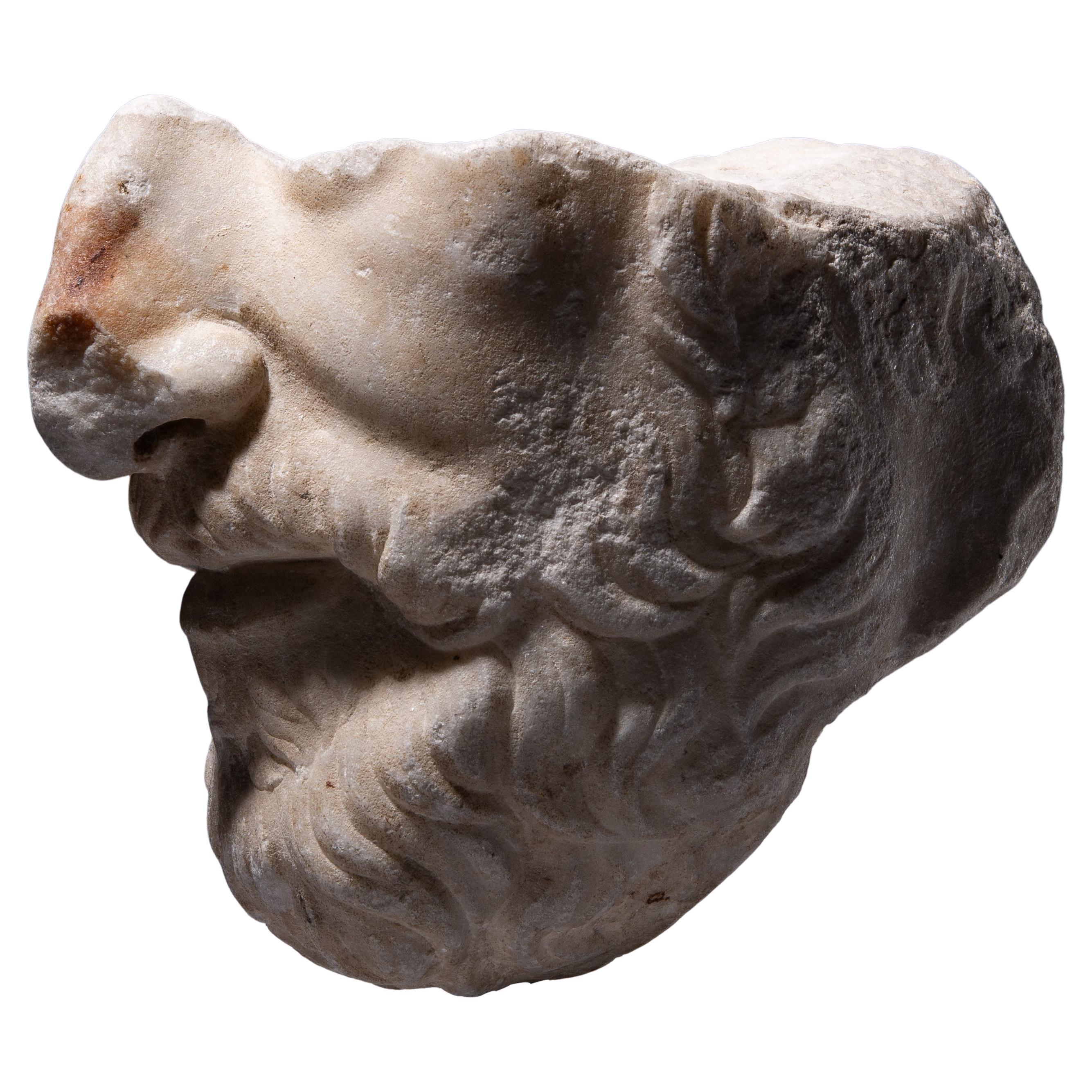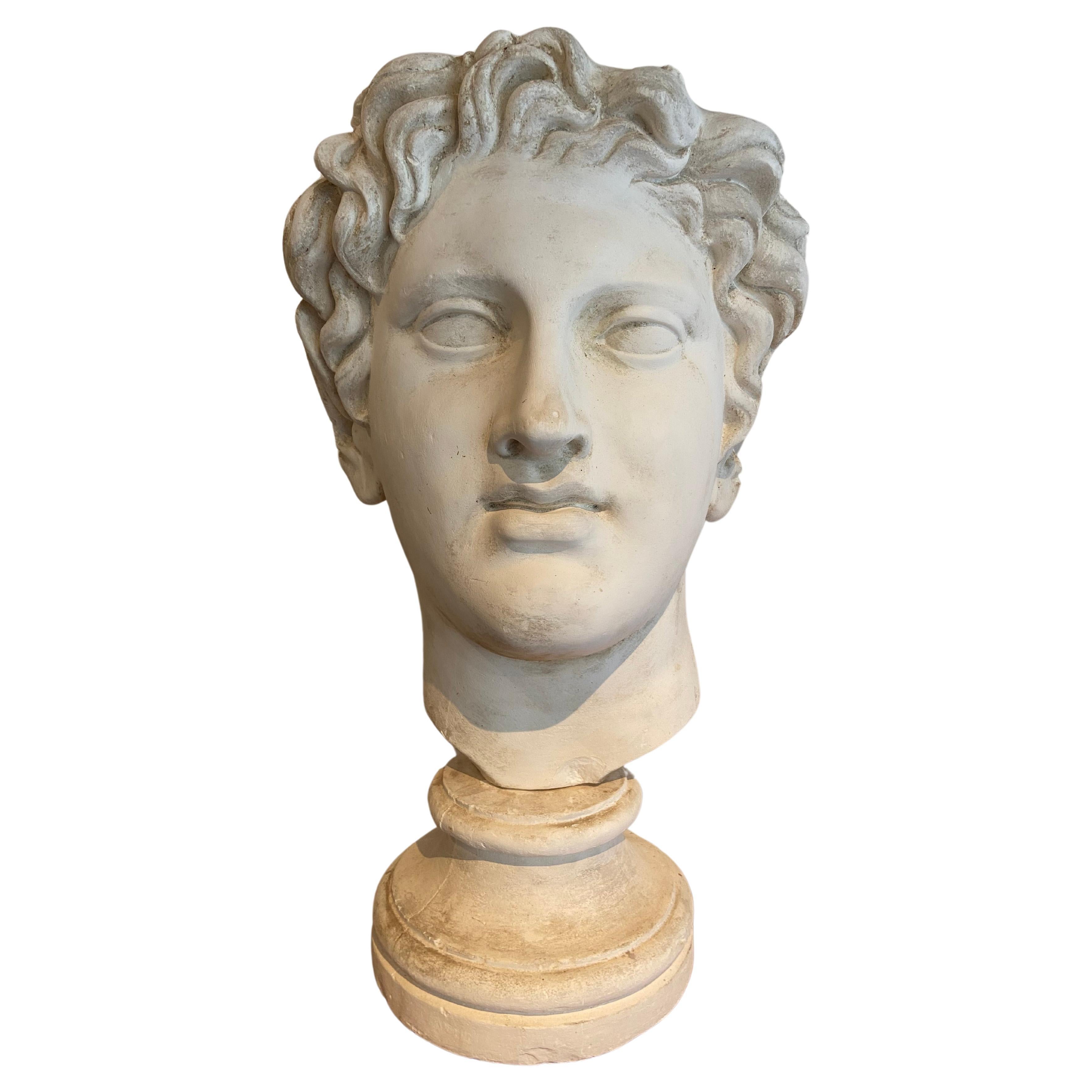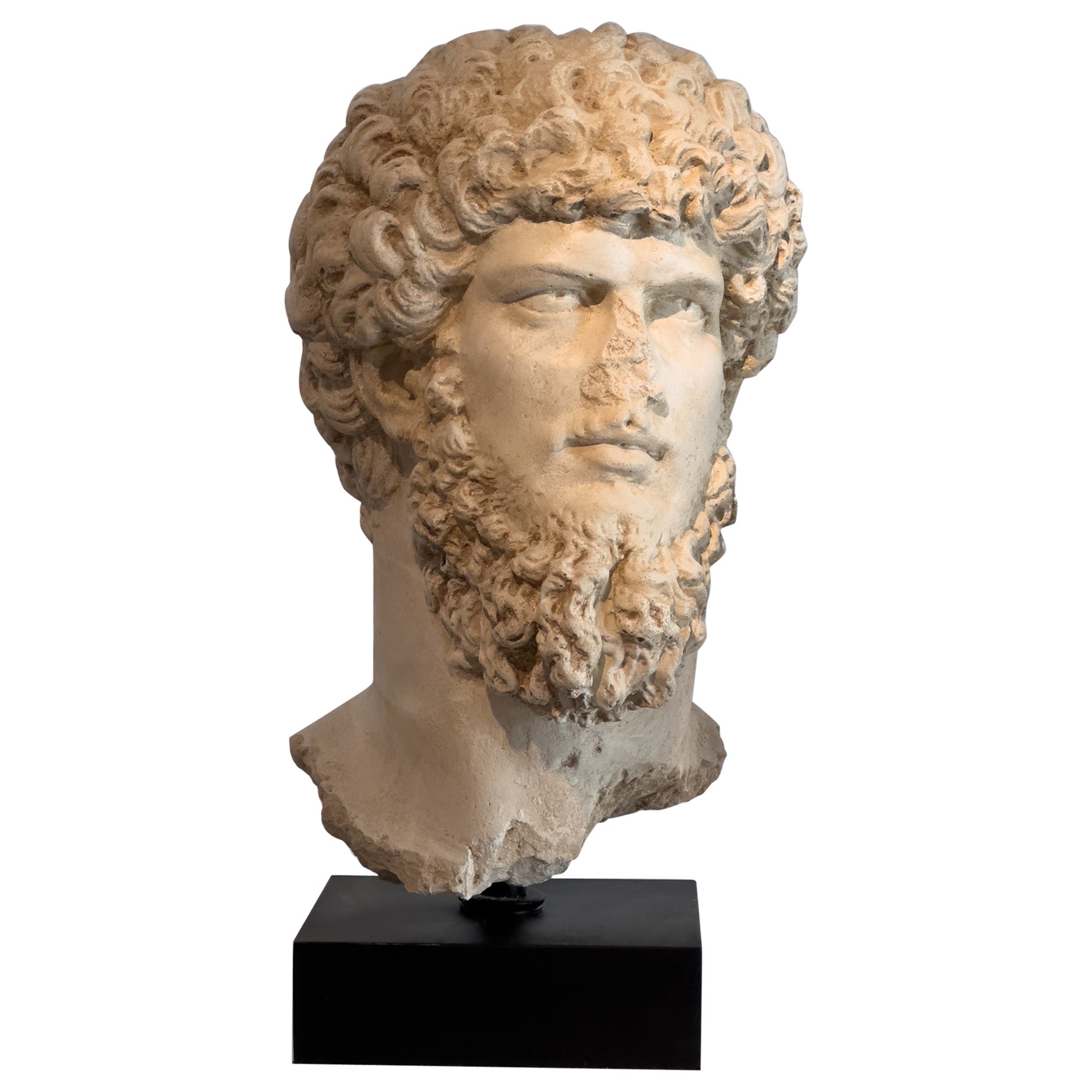Items Similar to An Over Life-Size Powerful Roman Male Portrait Head of Constantine the Great
Want more images or videos?
Request additional images or videos from the seller
1 of 5
An Over Life-Size Powerful Roman Male Portrait Head of Constantine the Great
About the Item
An Over Life-Size Powerful Roman Male Portrait Head of Constantine the Great (c.272 - 337)
Wearing the ‘Imperial Oak Wreath’ the decorative border of his ‘tunic’ can still be clearly seen on the left hand side
Marble
Italy
Early 4th Century AD
SIZE: 38cm high, 24.5cm wide, 25cm deep - 15cm high, 9¾ ins wide, 10 ins deep
PROVENANCE:
Ex Private collection, Cambridge, England
note:
For a very similar over life-size portrait head of Constantine I (the Great) wearing an identical wreath dating from the early 4th century AD see: Yorkshire Museum, York, inv. no. ‘YORYM’ 1998.23. Found in ‘Eboracum’ (York) in 1823
LITERATURE:
Rinaldi Tufi, S., Yorkshire. ‘Corpus Signorum Imperii Romani (Great Britain)’; vol. 1, fasc. 3, Yorkshire. Oxford University Press, 1983; 23, no. 38, pl. 12
In AD 306, Constantine was hailed emperor in the Roman city of York; he was the first emperor to convert to Christianity. Born in Naissus, the son of Flavius Constantius, and Helena, a woman of low birth and a christian. Following his campaigns in the eastern provinces, Constantine was recalled in 305 AD to fight alongside his father in the province of Britannia. After his father’s death in 306 AD, Constantine was acclaimed as ‘imperator’ by his army at Eboracum (York) eventually being declared victorious after the civil wars against emperors, Maxentius and Licinius to become sole ruler of the Roman Empire in 324 AD.
Constantine’s Christian belief cannot be underestimated, establishing the foundations of ‘Western Christendom’. In 313 AD he was influential in the proclamation of the ‘Edict of Milan, declaring tolerance of Christianity within the Roman Empire. The Church of the Holy Sepulchre, the purported site of Jesus’s tomb in Jerusalem, was built on his orders, considered the holiest place in all of ‘Christendom’.
The ‘age’ of Constantine marked a distinct epoch in the history of the Roman Empire marking a pivotal moment of transition from ‘classical antiquity’ to the ‘middle ages’. Building a new residence in the city of Byzantium, renaming it New Rome, which later become known as Constantinople, it subsequently become the capital of the ‘empire’ for the next one thousand years, the Eastern Roman Empire also known as the ‘Byzantine Empire’. Eventually known as modern day Istanbul.
- Dimensions:Height: 15 in (38.1 cm)Width: 9.75 in (24.77 cm)Depth: 10 in (25.4 cm)
- Style:Classical Roman (Of the Period)
- Materials and Techniques:
- Place of Origin:
- Period:
- Date of Manufacture:Early 4th Century AD
- Condition:Wear consistent with age and use. Minor losses.
- Seller Location:London, GB
- Reference Number:1stDibs: LU9363236850282
About the Seller
No Reviews Yet
Vetted Seller
These experienced sellers undergo a comprehensive evaluation by our team of in-house experts.
Established in 1989
1stDibs seller since 2023
- ShippingRetrieving quote...Ships From: London, United Kingdom
- Return PolicyA return for this item may be initiated within 14 days of delivery.
More From This SellerView All
- European Carved Limestone Celtic Votive Head of a Male WarriorLocated in London, GBA Large European Carved Limestone Celtic Votive Head of a Male Warrior Wearing a Typical Flowing Moustache Small Beard and Curling Locks of Hair Stiffened with Lime Wash the Slit Mouth Open as if in Command Circa 1st Century BC - 1st Century AD Size: 31cm high, 22cm wide, 25cm deep - 12¼ ins high, 8¾ ins wide, 9¾ ins deep / 42cm high - 16½ ins high (with base) From about 500 BC, first Greek and later Roman historians mention peoples living in a large area of non-mediterranean Europe as Celts. These classical chroniclers seem to have recognised these communities as having sufficient shared cultural traditions to justify their being given a common name, ‘Keltoi’ by the Greeks, and ‘Celtae’ or ‘Galli’ by the Romans. The earliest allusions to Celts by such Greek historians as Herodotus (485 - 425 BC) were followed by Polybius (200 - 118 BC) and Livy (59 BC - AD 17) who discuss the expansion of the Celts from their central European homelands during the 4th and 3rd centuries BC. They document the presence of Celts in Spain, France, Italy, Greece and Asia Minor, specifically central Turkey. They testify to the successful Roman resistance to the Celts in Italy, after the ignominy of the sacking of Rome by them in 387 BC, and describe the huge defeat suffered by the Celts at the battle of Telemon in northern Italy in 225 BC. The Celts in Greece who sacked the sacred site of Delphi in 279 BC were defeated by King Antigonos Gonatas of Macedon in 278 - 277 BC and in Turkey by Altalus of Pergamon in 240 BC. The Celts in Spain fell under the shadow of Rome from 2nd Century BC and the Celtic heartland known by the Romans as ‘Gaul’ was conquered by the Romans under Julius Caesar in the mid 1st Century BC. Britain was not referred to as Celtic by the ancient historians, but Caesar recognised the close similarities between Britain and Gaul especially in their political organisation. Tacitus (55 - 120 AD) and others chronicled the conquest of Britain between 43 and 84 AD some mentioning the fierce nature of the Celts who went into battle naked. Celtic art therefore belongs to an artistic tradition in the early history of Europe which is no less important than that of the classical world. Art was central to Celtic identity and was closely related to the objects which it decorated. The Celts were used to seeing art as an integral part of their everyday lives. Provenance: Ex Finch and Co...Category
Antique 15th Century and Earlier European Busts
MaterialsLimestone
- A Very Rare and Important Marble Relief of the ‘Resurrection of Christ’Located in London, GBA Very Rare and Important Marble Relief of the ‘Resurrection of Christ’ Attributed to the Master of the Mascoli Altar Marble Venice, Italy Second half of the 15th Century SIZE: ...Category
Antique 15th Century and Earlier Italian Renaissance Figurative Sculptures
MaterialsMarble
- A Polychrome and Parcel-Gilt Marble Group of the Virgin and ChildLocated in London, GBA Polychrome and Parcel-Gilt Marble Group of the Virgin and Child Attributed to Giovanni Di Balduccio (1317 - 1349) Marble Italy Circa 1330 - 1340 SIZE: 65cm high, 28cm wide - 25½ ins high, 11 ins wide PROVENANCE: Possibly Trivolzio Collection, Milan With Piero Tozzi Inc., New York Acquired by the William Randolph Hearst Foundation for The Los Angeles County Museum (A.5832.47-42), 1947 An auction of property de-accessioned by the Los Angeles County Museum of Art to benefit new acquisitions...Category
Antique 15th Century and Earlier Italian Figurative Sculptures
MaterialsMarble
- An Unusual and Rare English ‘Memento Mori’ Carved Shrine with Two Human SkullsLocated in London, GBAn Unusual and Rare English ‘Memento Mori’ Carved Shrine with Two Human Skulls to the underside, a carved ‘Dragonfly’ Marble 16th / 17th Century England Size: 36cm high, 28cm w...Category
Antique 16th Century English Figurative Sculptures
MaterialsMarble
- A Fine Large Wedgwood Black Basalt Library Bust of the Ancient Greek Epic Poet HBy WedgwoodLocated in London, GBA Fine Large Wedgwood Black Basalt Library Bust of the Ancient Greek Epic Poet Homer Impressed Wedgwood Mark 1780–1812 Early 19th Century Size: 59cm high – 23¼ ins high Provenance: Ex Finch and Co...Category
Antique Early 19th Century British Busts
MaterialsTerracotta
- A Hellenistic Funerary Stele in High Relief with Two Male HeadsLocated in London, GBA Hellenistic Funerary Stele in High Relief with Two Male Heads Marble Greek Hellenistic Circa 2nd Century BC Size: 20.5cm high, 38cm wide, 11cm deep - 8 ins high, 15 ins wide, 4...Category
Antique 15th Century and Earlier Greek Antiquities
MaterialsMarble
You May Also Like
- Life Size Antique Marble Bust of a Male in the Classical Roman Style, 1872Located in Tyrone, Northern IrelandLife size antique marble bust of a male in the classical Roman style wearing a toga. Carved in pure white statuary Carrara marble. Signed and dated “W. Theed Sc, Copio 1872” ...Category
Antique 19th Century English Neoclassical Revival Busts
MaterialsCarrara Marble
- Over Life-Size Bronze Sculpture of an Orientalist Female FigureLocated in London, GBStanding over two and a half metres tall, this sculpture is truly exceptional—an unusual, and remarkable, statement piece. The sculpture features a standing female figure, her dress ...Category
Antique Late 19th Century French Belle Époque Figurative Sculptures
MaterialsMalachite, Bronze, Ormolu
- Roman Style Gesso over Plaster Carved Head of Jupiter on Circular BaseLocated in Yonkers, NYA Roman style gesso over plaster carved head of the god Jupiter on circular base. Emanating the grandeur of ancient Rome, this verist representation of the god Jupiter, intricately c...Category
Antique 19th Century Classical Roman Busts
MaterialsGesso, Plaster
- Roman Marble Head of SophoclesLocated in London, GBRoman Marble Head of Sophocles Circa 1st-2nd Century Marble This fine Roman marble head preserves the proper left side of the face of a middle-aged man, with broad nose, soft lips, and bearded chin. The short beard and sideburns have been finely carved with a flat chisel, to render the soft, wavy strands of hair. The cheekbone, undereye, and nasolabial folds have been delicately modelled in the marble by a skilled hand. In a letter from 1975, the former director of Ny Carlsberg Glyptotek, Copenhagen, suggested that the head could depict the Ancient Greek tragedian Sophocles. Few figures in the Classical world stand aside Sophocles (c. 496-406 BC), inarguably the best known of the Athenian tragedians, in terms of the impact his works have had on the history of art and literature. The psychological depth he achieves in the seven of the 123 of his plays that have survived to the present day - most notably the three Theban plays: Antigone, Oedipus the King, and Oedipus at Colonus - not only inspired the Athenians, among whom Sophocles was honoured as a hero long after his death, but in our own time, have provoked landmark works on phychoanalysis and literary criticism, by thinkers like René Girard and, most famously, Sigmund Freud. In its masterful treatment of the marble this fragment sensitively captures the features of one of the most important playwrights of all time. Height on stand: 7.9 inches (20 cm). Provenance: Collection of Danish sculptor Jens Adolf Jerichau...Category
Antique 15th Century and Earlier Classical Roman Busts
MaterialsMarble
- Stucco head of a roman figureLocated in 'S-HERTOGENBOSCH, NLStucco head of a Roman figure. Signed on the back (unknown). The head is separate from the base.Category
Vintage 1950s Italian Classical Roman Busts
MaterialsStucco
- Head of Lucius Verus in the antique roman styleLocated in Madrid, ESBust of Lucius Venus made of moulded and carved limestone, following models of classical Rome. It is solid stone. It is part of a series of 8 copies distributed exclusively by our g...Category
21st Century and Contemporary Spanish Classical Roman Busts
MaterialsCast Stone





